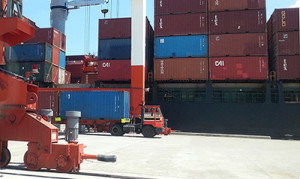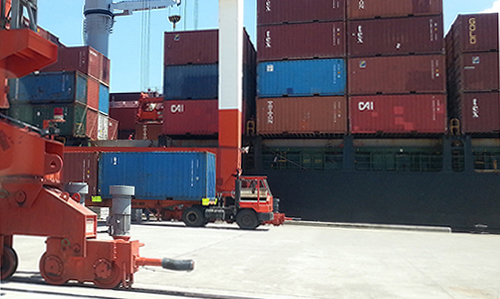
The Bureau of Customs (BOC) will soon release guidelines covering diversion of vessels from Manila to other ports.
In a draft provided to PortCalls, BOC said the guidelines are being made “in response to the imbalance between ships waiting to discharge cargo in MICP (Manila International Container Port) and POM (Port of Manila).”
Some members of the Association of International Shipping Lines in a general membership meeting last Nov 5 said the lack of guidelines from BOC and the Philippine Ports Authority hinders carriers from diverting calls to Subic or Batangas from the congested Manila port.
The vessel diversion complies with Executive Order No. 172 signed September 13, which designates the ports of Subic and Batangas as extension ports of Manila in cases of congestion and emergencies.
Atty. Maximino Cruz, general manager of AISL, told PortCalls on the sidelines of the association’s meeting that there are no implementing rules yet for EO 172. One shipping line, he said, has already sent a letter to the Customs commissioner for the issuance of such rules.
Cruz noted issues that should be tackled in the regulations include what happens to the manifest of vessels subject to diversion and the issue of payment of duties and taxes.
During the AISL meeting, an official of BOC Subic said a vessel recently diverted to Subic from Manila was discharged under “special” circumstances precisely due to the lack of implementing rules.
Under the draft BOC rules, customs will authorize the clearance of imports carried by vessels that arrive at a port of discharge different from the declared port of discharge as originally lodged in BOC’s electronic-to-mobile (e2m) system. Such authorization must be obtained for each vessel arrival.
Shipping lines with filed manifests in the e2m system showing an original port of discharge must request for and receive prior authorization from BOC before it can discharge goods at a new port. Liners must also obtain the required authorization from other government agencies.
For the BOC to authorize the diversion, shipping lines must “commit to compensate any importer or broker for any costs incurred” for “filing an import entry or otherwise complying with a customs procedure in the original port of discharge, which then have to be repeated in the new port of discharge, including but not limited to the costs of the Import Entry and Internal Revenue Declaration (IEIRD), the costs of lodging an entry through a Value Added Service Provider (VASP).”
The shipping line must also request authorization from the district collector of the original port of discharge specifying the following:
- Expected date of discharge in the original port of discharge
- Proposed new port of discharge
- Expected date of discharge in the new port of discharge
The district collector of the original port of discharge will make the final decision on the request of a shipping company “as soon as possible, and in all cases within 24 hours from receipt of the request for specific authorization.”
If the 24th hour falls on a Saturday, Sunday, or holiday, the authorization should be given at that time on the next working day, the draft order noted.
It is also the responsibility of the shipping line to inform its consignees which shipments will be diverted.
Once the district collector of the original port of discharge approves the request, the shipping company will have to re-file all manifests in the e2m indicating the new port of discharge and using the same bill of lading (B/L) numbers in the previous filing of manifest.
At the port of original discharge
The port of original discharge, for its part, will notify, through its district collector, the three VASPs of the change in the port of discharge for a particular registry number. The VASPs should then do the following:
- For any B/L with a registry number whose entry has not been filed, the VASPs should no longer accept the lodging of any entries in the e2m.
- For any entries that have been filed but were not yet paid for, the VASPs should no longer accept any changes in the status of the entry, including any final assessments or payments.
Once the district collector receives confirmation from all three VASPs that the requirements have been fulfilled, it will request BOC’s Management Information System and Technology Group (MISTG) to generate a list containing the following information for all B/L with the registry number whose port of discharge was changed:
- B/L for which no entry was filed
- B/L for which entry was filed but payments were not yet made, showing both BL number and entry number
- B/L for which entry was filed and payments were made which were tagged red by the Risk Management Office (RMO), showing both BL number and entry number
- B/L for which entry was filed and payments were made and which was not tagged red by the RMO, showing both BL number and entry number
After MISTG compiles this list, the district collector will give copies of these lists to the heads of the Formal Entry Division (FED), Warehousing Assessment Division (WAD), and deputy collector for operations (DCO) , who will gather the original documents for the consumption, warehousing, and transhipment entries, and take action depending on the status of the entry.
BOC noted that these tasks should be completed no later than the Monday, or the first working day of the week immediately after receipt of instructions from the district collector.
After all these, the district collector will have to write and notify the district collector of the new port of discharge and send all the original documents. The district collector must also ensure that brokers or importers who filed entries in the e2m but did not pay yet, or who filed for transshipment permits, are able to retrieve any paper documents from the offices where these were filed.
At the new port of discharge
Once the shipping line has refiled its manifest, the new port of discharge, for its part, must allow importers or brokers to file an entry for shipments with no previously filed entry, or for which entry was filed in the original port of discharge but payments were not yet made, as if no entry had previously been filed.
The district collector of the new port of discharge will then send the original files from the original port of discharge to the appropriate divisions (FED for consumption entries, WAD for warehousing entries, and DCO for transshipments).
For earlier paid entries tagged red, the appropriate division chief will assign each of these entries to a specific examiner (COO III) to record the findings in the IEIRD. For derogatory findings, the examiner will conduct any additional assessments and ensure payment before release.
- If there are no findings, the appropriate division head will recommend to the district collector the manual release of the shipment.
- If the findings result in the assessment of additional duties, taxes, or penalties, the appropriate division head will ensure that these are paid, then recommend to the district collector the shipment’s manual release.
- If the findings result in a recommendation to issue a warrant of seizure and detention, then the appropriate division head will notify the district collector.
- For entries previously paid and not tagged red, the district collector will authorize their manual release.
The MISTG will be responsible for ensuring that for purposes of making modifications to the entry in e2m as a result of examination, the COO III or other persons authorized by the appropriate division chief are able to make such modifications in e2m.
For any shipment for which entry is filed in the new port of discharge, COO IIIs and their equivalents in the FED, WAD, and DCO are authorized to accept paper B/L and other documents which show the original port of discharge rather than the new port of discharge, without any need to amend the inward foreign manifest. This applies only to documents where the discrepancy between the printed document and the electronic document is the port of discharge, and even then only if the port of discharge was changed pursuant to the memorandum order. – Roumina Pablo





